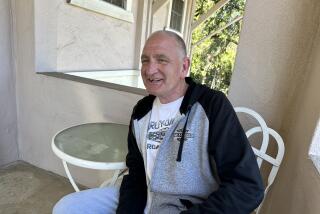Youngsters Act Out the Ways to Say No
- Share via
Shain West leaned over a table, put a straw to his nose and snorted. A satisfied smirk spread across his round face as he looked up and handed over crisp dollar bills to Michael Haskell. The two 12-year-olds bent back over the table until Isaiah Nixon walked by.
“This is good stuff,” Shain told Isaiah, “Come on. Get some. Hey, I’ll give it to you for free.” Isaiah, 10, looked straight at his two friends, said “no” softly but firmly and walked away.
With that, the small group surrounding the boys burst into applause and a counselor for the Boys & Girls Club of La Habra took over. “You know what I liked about that?” said Stan Carter as he walked into the middle of the crowd. “I liked the way Isaiah said no. Not like he was mad but still real convincingly.”
It was all part of a federally funded drug prevention program designed to teach young people how to deal with pressure from peers to experiment with drugs. The 14-week pilot program, at Boys Clubs in La Habra and nine other cities, was so successful that it’s being expanded to 200 Boys Clubs nationwide.
The program is called “Stand Up and Be Counted!” Each club involved in the pilot program, which also focused on alcohol and pregnancy prevention, received an $18,000 grant.
Participants were given written tests before and after the program to determine its effects on their attitudes about drugs, alcohol and sex.
“The tests were designed especially for the program by the University of Pennsylvania,” said Dick Guthrie, executive director of the La Habra club. “The kids didn’t have to identify themselves--only the computer could tell.”
Guthrie says he is “very pleased” with the test results.
The 43 youths from the La Habra club who participated were divided into two small groups: one for 10- to 12-year-olds that emphasized resistance to peer pressure and one for 13- to 15-year-olds that emphasized decision-making skills.
The role-playing, says Carter, was a popular attraction.
“The kids just ate it up,” he said. “We set up typical situations the kids might run into at school, a party or at a concert, and they acted out a bit of the scenario. It was very popular.”
During a recent role-playing session, some of the props, like the money, were real. But table sugar was substituted for cocaine, soda for beer and rolled up pieces of paper for marijuana cigarettes. The acting, however, was near Academy Award level.
“This is some new stuff,” slurred Kenneth Nash Jr., pretending to smoke marijuana as his father, Kenneth Nash Sr., looked on. The 12-year-old passed the “joint” to his friend, Justin Marshall, 10, and called out to another boy, “Hey Anthony, you want some of this? It makes me feel good! It makes me feel powerful!”
Anthony Ortiz, 11, suggested the two boys do other things to feel powerful. “Like play basketball,” he said.
The elder Nash, a manager with Hughes Aircraft Co., is one of two parents who participated in the pilot program. Nash was part of the “12-member prevention team,” which included six 16- and 17-year-old club members, another parent, two community members, Carter and Guthrie.
To prepare for the program, the prevention team attended a five-day training program in Arlington, Tex., that often lasted from 8 a.m. until 9 p.m. There they met with national drug, alcohol and teen-pregnancy experts.
The expansion of the pilot program to 200 clubs is the second phase of a three-year campaign, Guthrie said.
More to Read
Sign up for Essential California
The most important California stories and recommendations in your inbox every morning.
You may occasionally receive promotional content from the Los Angeles Times.













